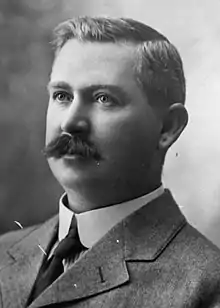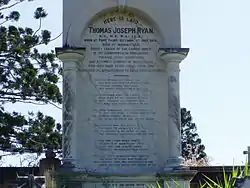T. J. Ryan
Thomas Joseph Ryan KC (1 July 1876 – 1 August 1921) was an Australian politician who served as Premier of Queensland from 1915 to 1919, as leader of the state Labor Party. He resigned to enter federal politics, sitting in the House of Representatives for the federal Labor Party from 1919 until his premature death less than two years later.
T. J. Ryan KC | |||||||||||||
|---|---|---|---|---|---|---|---|---|---|---|---|---|---|
 Ryan in 1920 | |||||||||||||
| 19th Premier of Queensland Elections: 1915, 1918 | |||||||||||||
| In office 1 June 1915 – 22 October 1919 | |||||||||||||
| Monarch | George V | ||||||||||||
| Governor | Hamilton Goold-Adams | ||||||||||||
| Deputy | Ted Theodore | ||||||||||||
| Preceded by | Digby Denham | ||||||||||||
| Succeeded by | Ted Theodore | ||||||||||||
| Leader of the Opposition in Queensland | |||||||||||||
| In office 6 September 1912 – 1 June 1915 | |||||||||||||
| Premier | Digby Denham | ||||||||||||
| Deputy | Ted Theodore | ||||||||||||
| Preceded by | David Bowman | ||||||||||||
| Succeeded by | Edward Macartney | ||||||||||||
| Leader of the Labor Party in Queensland | |||||||||||||
| In office 6 September 1912 – 22 October 1919 | |||||||||||||
| Deputy | Ted Theodore | ||||||||||||
| Preceded by | David Bowman | ||||||||||||
| Succeeded by | Ted Theodore | ||||||||||||
| Member of the Queensland Legislative Assembly for Barcoo | |||||||||||||
| In office 2 October 1909 – 14 October 1919 | |||||||||||||
| Preceded by | George Kerr | ||||||||||||
| Succeeded by | Frank Bulcock | ||||||||||||
| |||||||||||||
| Personal details | |||||||||||||
| Born | Thomas Joseph Ryan 1 July 1876 Port Fairy, Victoria Colony, British Empire | ||||||||||||
| Died | 1 August 1921 (aged 45) Barcaldine, Queensland, Australia | ||||||||||||
| Cause of death | Pneumonia | ||||||||||||
| Resting place | Toowong Cemetery | ||||||||||||
| Political party | Labor | ||||||||||||
| Spouse(s) | Lily Virginia Cook
(m. 1910; | ||||||||||||
| Education | South Melbourne College Xavier College, Melbourne | ||||||||||||
| Alma mater | University of Melbourne (BA, LLB) | ||||||||||||
| Occupation | Barrister, teacher | ||||||||||||
Ryan was born in Port Fairy, Victoria, to Irish immigrant parents. He studied arts and law at the University of Melbourne, and for several years worked as a schoolteacher at various private schools around Australia. He eventually settled in Queensland and entered the legal profession, working as a barrister in Brisbane. Ryan was elected to the Queensland Legislative Assembly in 1909, and became leader of the Labor Party in 1912. He led the party to victory at the 1915 state election, the first time it had secured majority government in Queensland.
As premier, Ryan led a reforming government that implemented many of the planks in the Labor platform, including the expansion of workers' rights, the implementation of price controls, and the establishment of new state-owned enterprises. After the Labor Party split of 1916, Queensland had the only remaining Labor government in Australia, giving him a national profile. The government was re-elected at the 1918 state election, but the following year Ryan resigned to enter federal politics, winning the Division of West Sydney in New South Wales at the 1919 federal election. He was widely seen as the heir apparent to the Labor Party's federal leader, Frank Tudor, who was in poor health. His sudden death from pneumonia at the age of 45 was seen as a major blow for the labour movement.
Early life
Thomas Joseph Ryan was born at Port Fairy, Victoria Australia, the fifth of six children of Timothy Joseph Ryan, an illiterate Irish labourer who had migrated to Victoria in 1860 and become a small farmer, and his Irish wife Jane, née Cullen (died 1883). Tom's father shared his keen interest in politics with his family but was himself never politically active.
Ryan was educated at South Melbourne College, Xavier College, Kew, and the University of Melbourne, where he graduated B.A. and LL.B.
He was appointed an assistant classical master at the University High School, Melbourne, and subsequently held teaching positions at the Launceston Church Grammar School, at the Maryborough Grammar School, and the Rockhampton Grammar School, where he became second master. He resigned this position on being admitted to the Queensland bar in December 1901. He practised as a solicitor at Rockhampton and subsequently as a barrister at Brisbane. While at Rockhampton in 1900 he joined the Australian Natives' Association and became its local president.
Queensland politician

He was afterwards a candidate for the federal seat of Capricornia and the state seat of Rockhampton North, but was defeated on both occasions. In October 1909 he was elected as Labor member for Barcoo in the Legislative Assembly of Queensland, retained the seat for 10 years, and after the 1912 election was elected leader of the Labor party on the resignation of David Bowman.
The Ryan government was the first majority Australian Labor Party government of Queensland as a result of the 1915 election. Some of the eight members of his Cabinet had connections with the early ALP of the 1880s and the Shearer's Strike. His government would provide the example which would see Labor in power in Queensland almost continuously until 1957. Major reform of Labor laws and agricultural policy was part of the Ryan legacy. At the election in May 1915, Labour came in with a large majority and Ryan became premier, chief secretary, and Attorney-General, and an era of industrial legislation and state enterprise began. Among the measures passed were the industrial arbitration act, labour exchanges act, workers' compensation act, inspection of machinery and scaffolding act, factories and shops amendment act, and workers' compensation amendment act. This was one side of the Ryan government's activities but where it particularly broke fresh ground was the entrance of the state into trading activities. Stations were purchased and run as going concerns, and many retail butchers' shops were opened in Brisbane and other parts of Queensland. Railway refreshment rooms were taken over, state hotels were built and purchased, a producing agency was established, coal mines were acquired, iron and steel works were opened, and a state insurance department was established. In addition, Cane price boards were set up, providing fair returns for growers and fair wages for sugar workers. Women were given the right to stand for parliament, industrial reforms were carried out which gave workers a "new deal," and a chain of butchers' shops was established which sold meat cheaper than elsewhere and proved to be very popular.[1]
Ryan showed good generalship at the 1918 election and his party was again returned with a large majority. The defection of Prime Minister Billy Hughes and several others—including New South Wales Premier William Holman—to the non-Labor side left Ryan as the head of the only Labor government at any level in Australia. As such, he was instrumental in leading the fight against conscription in the plebiscites launched by Hughes in 1916 and 1917. Friction between Hughes and Ryan almost led to violence in November 1917 when the Australian federal government conducted a raid on the Government Printing Office in Brisbane, to confiscate copies of Hansard that covered debates in the Queensland Parliament where anti-conscription sentiments had been aired. On 29 November 1917, Prime Minister Billy Hughes travelled to Warwick, southern Queensland, to recruit support for the 1917 Australian conscription referendum. An egg was thrown resulting in the formation of the Australian Federal Police.

Federal politician
Ryan was asked by a resolution of a special federal conference to enter federal politics, the only occasion that such a motion has been passed. He was Campaign Director for the Labor Party during the 1919 Federal election and was elected to the House of Representatives in the Federal Parliament as the Member for West Sydney. In 1920, he was appointed King's Counsel. He had been widely touted as a likely Labor leader before his premature death.[2]
Although a big man physically, Ryan was not strong in health. Weakened by influenza while he was in England at the time of the 1919 epidemic, he suffered repeatedly thereafter from bronchial and nasal infections. Furthermore, he was tired from overwork; he seldom took a holiday. In July 1921 he set out to campaign for the Labor candidate William Dunstan in the by-election for the Federal seat of Maranoa; he was sick at the start and during the long trip his condition worsened. On 1 August 1921 he died in Glenco Hospital, Barcaldine, Queensland, of pneumonia. His body was taken by train to Brisbane, past crowds gathered at each station. Archbishops Duhig and Mannix presided over his funeral in St Stephen's Cathedral and his burial in Toowong Cemetery.
Personal life
He married in 1910, Miss Lily Virginia Cook. She survived him with a son and a daughter, and in 1944 was the Queensland government representative at Melbourne.
Legacy

The early death of such a capable leader was a great blow to the labour movement. He was described as urbane, amiable and approachable; his personality had allowed him to converse with confidence and trust with people of all ranks, from the governor of the Bank of England to militant unionists. At the same time he could hit hard with sarcasm when challenged by foes such as Hughes; yet he remained friendly with numerous fellow parliamentarians, including some of his firmest conservative opponents. Charles Bernays regarded him as the greatest parliamentary leader he had observed, 'an earnest exponent of the faith that was in him, and a generous big-hearted fighter'. Many historians believe that Ryan (a much bolder figure than federal Labor leader Frank Tudor) would have been Australia's fourth ALP Prime Minister, had he lived just a few years more.[4] A memorial fund collected money to erect a ten-foot (3 m) bronze statue which stands in Queen's Park near the Old Executive Building. A Ryan medal was struck for candidates obtaining the highest pass in the annual State scholarship examination.
The wording on the metal plaque on the pedestal on which Thomas Ryan's statue stands in Brisbane, describes him as: Scholar - Jurist - Statesman. The Federal electoral division of Ryan is named after him.
See also
References
- Ross McMullin, The Light on the Hill: The Australian Labor Party 1891-1991
- Featured Chambers Issue 32 Archived 26 February 2011 at the Wayback Machine — Hearsay – The Journal of the Bar Association of Queensland
- Ryan, Thomas Joseph Archived 13 June 2012 at the Wayback Machine — Brisbane City Council Grave Location Search
- Johnston, W. Ross; D. J. Murphy. "Ryan, Thomas Joseph (1876 - 1921)"
Bibliography
- Queensland Political Portraits 1859-1952, University of Queensland Press, 1978
- Johnston, W. Ross; D. J. Murphy. "Ryan, Thomas Joseph (1876 - 1921)". Australian Dictionary of Biography. Australian National University. Retrieved 31 May 2007.
- Serle, Percival (1949). "Ryan, Thomas Joseph". Dictionary of Australian Biography. Sydney: Angus and Robertson.
External links
| Wikimedia Commons has media related to T. J. Ryan. |
| Political offices | ||
|---|---|---|
| Preceded by Digby Denham |
Premier of Queensland 1915–1919 |
Succeeded by Ted Theodore |
| Preceded by David Bowman |
Leader of the Opposition of Queensland 1912–1915 |
Succeeded by Edward Macartney |
| Preceded by David Bowman |
Leader of the Labor Party in Queensland 1912–1919 |
Succeeded by Ted Theodore |
| Parliament of Queensland | ||
| Preceded by George Kerr |
Member for Barcoo 1909–1919 |
Succeeded by Frank Bulcock |
| Parliament of Australia | ||
| Preceded by Con Wallace |
Member for West Sydney 1919–1921 |
Succeeded by William Lambert |